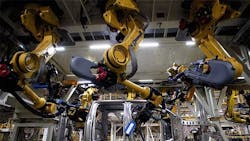Working here at MEP, I get incredible opportunities to interact with manufacturers from all around the nation. From plastics and chemicals to electronics and machinery, it’s simply marvelous to see all of the incredible things that manufacturers produce, and hear the stories about the companies and people who create them.
Despite coming from different sectors, sizes and regions, I’ve noticed some common themes emerging from them all. Based on these stories, I have some predictions I’d like to share about how the manufacturing industry is going to progress throughout the remaining quarters of 2016.
Although it’s impossible to know what’s going to happen for sure (As Yogi Berra said, “It’s tough to make predictions, especially about the future.”), here are my top four “bold predictions” for U.S. manufacturing in the coming months ahead:
1) Supply Chains Become More Domestic
Whether you’re a smaller manufacturer or a large original equipment manufacturer (OEM), supply chains significantly impact the competitiveness and effectiveness of your company. Manufacturers will move past a laser focus on price and alternatively will think more strategically about developing better collaborations, integrated systems, and synergies.
A strong supply chain is one that provides the optimal operation of manufacturing and distribution. Global supply chain disruptions can be particularly harmful to businesses, and that’s why OEMs will move to work with more American manufacturers for the North and South American markets. By partnering with other U.S. manufacturers and organizations, companies can develop effective domestic supply chains and realize benefits such as:
- Lowered production costs
- Diminished risk
- Protection of intellectual property
- Improved quality and reliability
- Increased efficiencies
- Decreased lead and delivery times
- Boosted output
- Reduced inventory
2) More Manufacturers Focus on Growth through Exporting
Maintaining sales and clients isn’t enough – it’s all about growth. Did you know that 95 percent of the world’s customers live outside of the U.S.? If manufacturers aren’t exporting, they’re missing out on untapped markets and a whole new world of potentially profitable customers. And when companies enter new markets, they’re exposed to new cultures, buyers and experiences. These engagements can lead to new inspirations as to how manufacturers sell domestically to their primary target audiences.
Many manufacturers don’t believe they can export because they’re “too small” or are apprehensive about international regulations. In reality, more than two-thirds of exporters are estimated to have fewer than 20 employees according to Export.gov.
3) Manufacturers will Recognize the Competitive Advantages of Sustainability
Sustainability is more than a trend. U.S. manufacturers will increasingly realize that these initiatives can help them become more competitive and profitable. As energy costs challenge organizations, sustainable improvements can help companies reduce power and water expenses in the long-term. Switching to sustainable equipment and machinery can reduce utility bills or lower supply costs. There are also numerous tax incentives available to those who do.
In addition to cost savings, sustainability can help grow a business. Customers are starting to become more environmentally conscious, and consumers are increasingly favoring companies that are “going green.” Manufacturers can highlight their sustainability initiatives in their marketing and drive new sales.
4) Manufacturing Day 2016 will be a Resounding Success
The fifth annual National Manufacturing Day is set for Friday, October 7th, 2016. Established in 2012, the celebration was designed to improve the general public’s perception of manufacturing careers and the industry’s value to the economy. National Manufacturing Day is more than just a celebration; it’s every company’s opportunity to demonstrate the diverse careers offered in manufacturing.
Every year, the celebration gets bigger and bigger, and there is no doubt in my mind that National Manufacturing Day 2016 will exceed all of our expectations. Businesses, associations, educational institutions and MEP Centers, even the NIST Labs, will come together to organize and host events all throughout the nation. Open houses at manufacturing facilities will be held for students, educators and parents to demonstrate the dynamic careers that manufacturing has to offer. Last year, approximately 2,600 events celebrated modern manufacturing – this year we’ll have even more.
Learn more about National Manufacturing Day 2016, exporting, supply chains, and sustainability.
And there you have it…my predictions for the U.S. manufacturing community in the coming months. Check back in at the end of the year and see how I measured up.
The post Manufacturing in 2016: One Quarter Down, Three to Go appeared first on the Manufacturing Innovation Blog. Manufacturing Innovation Blog is powered by The Manufacturing Extension Partnership.
